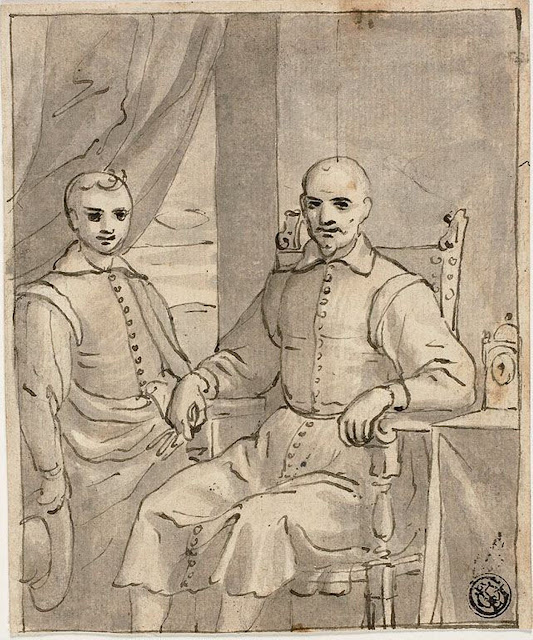 |
| Bernardo Castello Nativity ca. 1620 oil on canvas Indianapolis Museum of Art |
 |
| Bernardo Castello Penitent Magdalen before 1629 oil on canvas private collection |
 |
| Bernardo Castello Last Supper (study for painting) before 1629 drawing Royal Collection, Great Britain |
 |
| attributed to Bernardo Castello Design for Ceiling Decoration before 1629 drawing Rijksmuseum, Amsterdam |
 |
| Bernardo Castello Modello for Ceiling Fresco with Papal Coat of Arms before 1629 drawing Metropolitan Museum of Art, New York |
"Bernardo Castello was taught by Andrea Semino and subsequently by Luca Cambiaso. When the latter artist moved to Madrid in 1583, Castello emerged as one of Genoa's leading painters. Around this time he painted the Stoning of St Stephen (Palermo, S. Giorgio dei Genovesi), which was copied from Giulio Romano. But Cambiaso's influence had been so intrinsic to his development that Castello remained faithful to his style throughout his career. Other influences came from time spent in Rome and in Florence, where in 1588 he joined the Accademia del Disegno. In and around Genoa, Castello executed numerous fresco decorations, such as those in the Villa Lomellini Rostan (1583) at Multedo and at the Palazzo Spinola (1592-1593). In 1604 he was called to Rome, there to paint for St. Peter's an altarpiece depicting the Calling of St Peter, but this was soon replaced. On a later trip to Rome, Castello executed frescoes in the Palazzo del Quirinale and in the Palazzo Rospigliosi Pallavicino (1616)."
– from curator's notes at Museo del Prado
 |
| Bernardo Castello Roman Emperor receiving an Emissary ca. 1580-1600 drawing Museo del Prado, Madrid |
 |
| attributed to Bernardo Castello Evangelist standing in Niche ca. 1580-1600 drawing Museo del Prado, Madrid |
 |
| Bernardo Castello Design for an Altar Virgin and Child enthroned, with St John the Baptist and St Benedict before 1629 drawing Museo del Prado, Madrid |
"This drawing [directly above] is of particular interest since it shows an artist furnishing the design for his painted altarpiece, along with a scheme for the position of the altar it was intended to decorate – the top of which is indicated by the Maltese cross seen in perspective – and its architectural frame. The altarpiece, capped by a broken pediment, is set within a tablet that breaks forward from the Ionic pilasters and cornice to which it is attached. At the top of the structure, in the space left at the center of the broken pediment, is a figurine of the Infant Christ as Salvator Mundi: he holds the globe at his side with his left hand and raises his right in blessing. Castello presumably submitted the drawing to his ecclesiastical patrons for their approval, and his presentation of the whole scheme almost certainly indicates that he would have had charge over the construction of the entire monument, not just the painting of the sacra conversazione composition that forms its decorative focus. The utilitarian purpose of the study explains the unadorned, schematic quality of the drawing. Unfortunately, it is not clear whether this particular altar was destined for a private chapel within a church or whether it was to be merely positioned against the nave wall of such a church. The presence of St. Benedict standing on the right within the altarpiece design would appear to indicate that the altar decoration was destined for the Benedictine Order, the oldest western monastic Order."
– from curator's notes at Museo del Prado
 |
| Bernardo Castello Illustration to Gerusalemme Liberata Figures requesting Clemency (print study) ca. 1585-90 drawing Morgan Library, New York |
 |
| Bernardo Castello Illustration to Gerusalemme Liberata Scene in Armed Camp, with gesturing Ruler (print study) ca. 1585-90 drawing Art Institute of Chicago |
 |
| Bernardo Castello Illustration to Gerusalemme Liberata Olindo and Sophronia before the Sultan (print study) ca. 1585-90 drawing Teylers Museum, Haarlem |
 |
| attributed to Bernardo Castello Warrior kneeling before a King before 1629 drawing Royal Collection, Great Britain |
 |
| Bernardo Castello Sheet of Figure Studies ca. 1585-95 drawing Art Institute of Chicago |
 |
| attributed to Bernardo Castello Martyrdom of a Bishop before a Roman Emperor before 1629 drawing Rijksmuseum, Amsterdam |
 |
| Bernardo Castello Portrait of Seated Ecclesiastic and Standing Youth ca. 1610 drawing Art Institute of Chicago |
 |
| Bernardo Castello Triumph of Temperance before 1629 drawing National Galleries of Scotland |
 |
| Bernardo Castello Adoration of the Shepherds before 1629 oil on canvas National Galleries of Scotland |